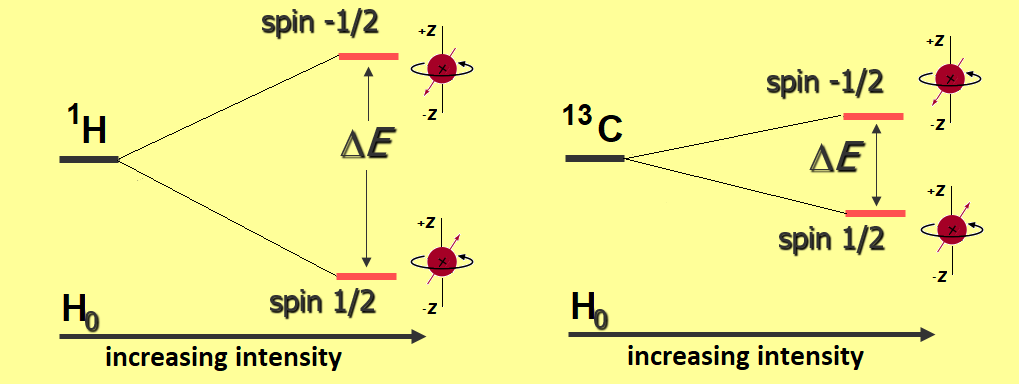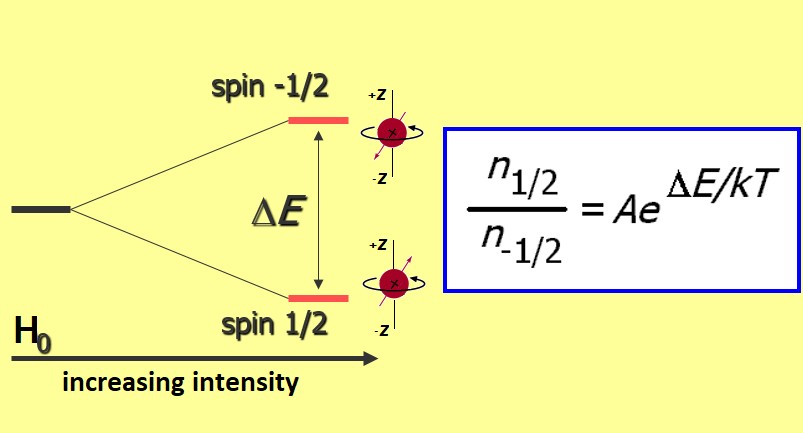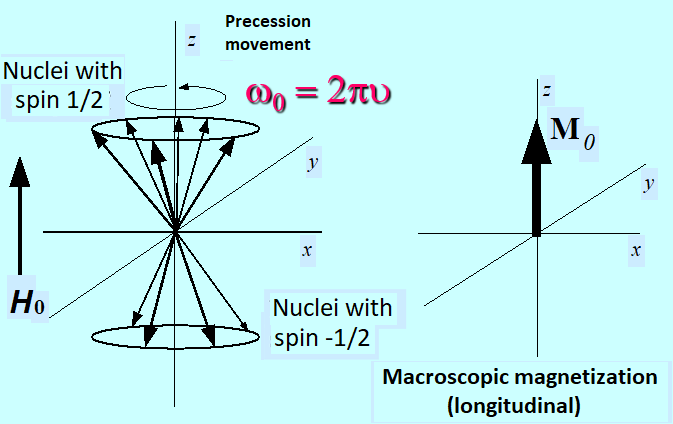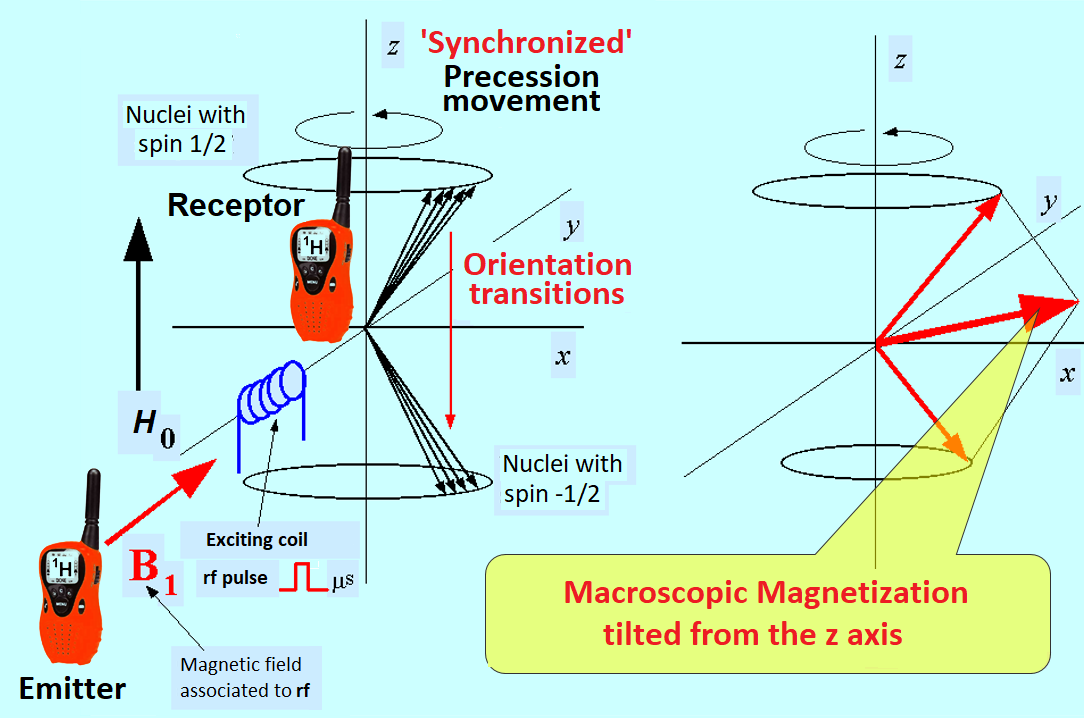INTERACTION WITH THE ELECTROMAGNETIC WAVES
In the previous section we left the methane molecules within the intense, external magnetic field (Ho).
The undistinguishably 1H nuclei split into two groups separated by a tiny but tangible amount of energy.
The 1% of 13C were also divided into two groups, separated by one fourth of the energy that separates 1H groups.
 Separation of the nuclei into two levels of energy by the action of the external magnetic field.
Separation of the nuclei into two levels of energy by the action of the external magnetic field.
The spectroscopic techniques (x rays, IR, EM) are always the result of a system perturbation. In x rays it is the diffraction the electrons exert on the incident radiation. In IR it is the vibration modes of the molecules that are perturbed by the IR radiation. In EM it is the ionization and ulterior trajectory deflection of the formed ions.
How can one produce a perturbation observable in NMR?
It is not conceptually difficult:
Irradiating the nuclei with an electromagnetic wave of identical frequency to that corresponding to the energy level separation between the two groups of nuclei, i.e. 80 MHz for 1H or 20 MHz for 13C, provided the nuclei are immersed in the 1.81 Tesla magnetic field. Please, review the previous section.
That's how the name "Nuclear Magnetic Resonance" makes sense: the "nuclei" are introduced into a "magnetic" field and their "resonance" is achieved by means of an electromagnetic wave.
Let's consider a certain number of methane molecules, for instance one mol (6,023·10^23 molecules). The nuclei don't exactly split into two 50% groups because, although tiny, there is an energy difference between the two levels which makes the lowest energy group n(1/2) be slightly more populated.
 Population ratio between the two levels of energy
Population ratio between the two levels of energy
 Vectorial composition of the nuclear magnetic vectors into the "macroscopic magnetization"
Vectorial composition of the nuclear magnetic vectors into the "macroscopic magnetization"
What is the effect of “resonance”?
It will make more sense to you if one considers the vectorial composition of all nuclear magnetic vectors, i.e. "macroscopic magnetization" (M0),
arising from the slight excess of population of the most stable group of nuclei.
Although beyond the scope of this course, let's just say that one of the consequences of the "gyromagnetic constant", characteristic to each isotope, is that the nuclear vectors cannot fully align with the external field and remain at a certain angle.
Following the physics' laws, an unaligned magnetic vector, relative to an external magnetic field, starts "spinning" ("precessing") around the external field axis, with a frequency corresponding to the energy separation of the two nuclei groups, "deltaE", i.e., 80 MHz for 1H or 20 MHz for 13C, in the field H0 of 1.81 Tesla, we have taken as a working example.
That graphically translates into the fact that the number of vectors "precessing" around +z axis is slightly higher than that doing it around -z.
Consequently, the vectorial composition of all nuclear vectors is not null and gives rise to the so-called "macroscopic magnetization" (M0), parallel to the external magnetic field.
What happens if one irradiates the system with an electromagnetic radiation (B1) of identical frequency to that of the nuclei "precession" and perpendicular to H0?
 Effect on "macroscopic magnetization" of our irradiation with an electromagnetic radiation B1.
Effect on "macroscopic magnetization" of our irradiation with an electromagnetic radiation B1.
Two phenomena take place at the same time:
1) Nuclei start coordinating their "precession" and begin spinning in phase.
2) Nuclei from the lower level get energy and promote to the higher level.
Please, consider that, for an external field of 1.81 Tesla, if the incident electromagnetic radiation is of 80 MHz, only 1H will be affected.
In order to perturb the 1% of 13C we'll have to use a radiation of 20 MHz, with which 1H nuclei won't be affected.
Each nucleus has its own channel, as if it were a “walkie-talkie”.
 Independent communication channels of an organic molecule in the NMR experiment.
Independent communication channels of an organic molecule in the NMR experiment.
The final result to keep in mind is that the longitudinal macroscopic component of magnetization deviates from the z axis.
This is the perturbation origin of the subsequent NMR signal.
If the electromagnetic radiation B1 is maintained for enough time, Mo ends up in the perpendicular plane (x,y) and turns into "transversal magnetization” (Mxy) relative to H0.
Remember that this is the consequence of two simultaneous phenomena:
1) Nuclei spinning in phase.
2) Nuclei promoting to the higher energy level.
Once the macroscopic magnetization lays in the x,y plane, the B1 irradiation is stopped.
At that very moment we turn our "walkie-talkie" from transmitting to receiving in order to "hear" how the system returns to the starting situation of equilibrium.
 Separation of the nuclei into two levels of energy by the action of the external magnetic field.
Separation of the nuclei into two levels of energy by the action of the external magnetic field.
 Population ratio between the two levels of energy
Population ratio between the two levels of energy
 Vectorial composition of the nuclear magnetic vectors into the "macroscopic magnetization"
Vectorial composition of the nuclear magnetic vectors into the "macroscopic magnetization"
 Effect on "macroscopic magnetization" of our irradiation with an electromagnetic radiation B1.
Effect on "macroscopic magnetization" of our irradiation with an electromagnetic radiation B1.
 Independent communication channels of an organic molecule in the NMR experiment.
Independent communication channels of an organic molecule in the NMR experiment.